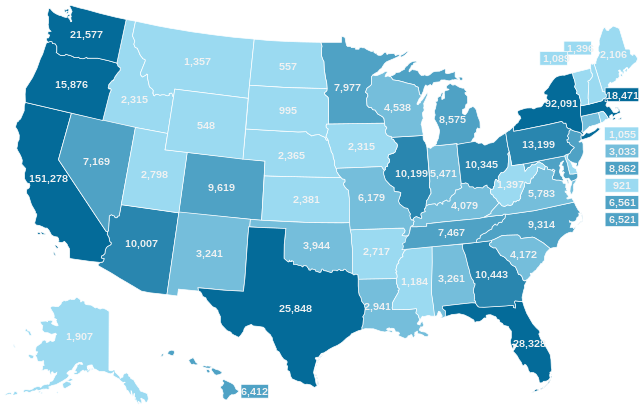Homelessness is a persistent and complex issue affecting major cities across the United States. Recent estimates suggest there are over 500,000 people experiencing homelessness nationwide on any given night. The rise in homelessness over the past decade, especially among vulnerable populations like veterans, youth, and families with children, underscores the need for comprehensive solutions to address this crisis.
The Scope of the Problem
Homelessness looks different across various cities and regions, but some trends are clear. The lack of affordable housing, steady jobs that pay a living wage, and access to healthcare and support services have all contributed to increased homelessness. Major cities like New York, Los Angeles, Seattle, and San Francisco have seen large increases in their homeless populations. For example, it’s estimated there are over 60,000 homeless individuals in Los Angeles County alone. The rise in homelessness has strained city resources and led to makeshift encampments forming in public spaces.
Contributing Factors
Several interrelated factors contribute to homelessness among individuals and families. The lack of affordable housing across major cities is a primary driver, especially as rents and home prices have skyrocketed. Stagnant wages and income inequality also make stable housing difficult to maintain for low-income households. For certain subgroups like veterans, mental illness and PTSD may contribute to job loss and housing instability. Domestic violence is also a common cause of homelessness among women. Without a support system, a single life event like job loss or medical emergency can quickly spiral into homelessness.
Public Health Impacts
Homelessness has wide-ranging impacts on public health and safety in cities. People experiencing homelessness have higher rates of physical and mental illness, substance abuse, and shortened life expectancies. Encampments may lack proper sanitation or access to clean water and healthcare, increasing risk of disease transmission. Lack of stable housing also makes it difficult to manage chronic physical and mental health conditions. From a public safety perspective, increased street homelessness may contribute to petty crime and diminished perceptions of neighborhood safety and cleanliness.
Potential Solutions
While homelessness is a complex issue without a single solution, cities can employ multiple strategies to help alleviate this crisis. Some of the most promising solutions include:
- – Increasing affordable housing stock through zoning policies, rent controls, and development incentives
- – Expanding rental assistance programs and housing vouchers
- – Investing in supportive housing models that provide social services alongside housing
- – Improving coordination between healthcare systems, homeless services, and housing authorities
- – Implementing centralized data systems to match homeless individuals with appropriate housing options
- – Expanding mental health and substance abuse treatment resources
- – Offering job training, placement, and other employment support services
- – Deploying street outreach teams to connect those experiencing homelessness with available resources
- – Considering pilot programs to provide temporary shelter or authorized encampments
A combination of short-term emergency measures and long-term system reforms is required. Solutions must be tailored to each city’s needs and resources. But by learning from successful models and making housing solutions a priority, major cities can create real change.
Additional Solutions
Housing First Approaches
The Housing First model has shown promising results in cities like Salt Lake City and Houston. This approach quickly provides permanent housing without prerequisites or conditions, paired with supportive services as needed. Prioritizing rapid placement into stable housing can be cheaper than managing homelessness long-term. Housing First programs help combat myths that those experiencing homelessness need to “earn” housing or that providing housing enables substance use. This approach has been successful for both chronically homeless individuals and families.
Innovative Architectural Designs
Some cities are getting creative with converting underutilized spaces into affordable housing options. Examples include micro-unit apartments, modular housing, and converting shipping containers into housing units. These innovative designs can provide transitional or permanent housing quickly and cheaply. Architectural competitions and partnerships with developers can spur creative solutions.
Prevention and Diversion Programs
Initiatives focused on prevention can keep at-risk individuals and families from becoming homeless in the first place. Strategies include short-term rental assistance, mediation programs for landlord disputes, and cash assistance for security deposits or moving costs. For those newly homeless, diversion programs quickly re-house them without needing to enter the shelter system, which is traumatic and costly. Identifying people’s support networks is key.
Street Outreach and Encampment Management
Street outreach teams work directly with people living in encampments or public spaces to build trust and connect them to services and housing options. Best practices include having formerly homeless workers on outreach teams. Encampments can also be managed through designating authorized locations, providing basic sanitation services, and partnering with residents to transition to shelters or housing.
While expanding affordable housing is critical, wraparound services are also vital to ensuring people can obtain and retain stable housing. A continuum of care is needed, from temporary shelters to transitional housing to permanent supportive housing. Cities must also address root causes like lack of fair wages, access to healthcare, and support systems to decrease the risk of homelessness.
Conclusion
Homelessness requires a multi-faceted response from cities, community organizations, and government agencies. While major cities have made progress through increased funding and pilot initiatives, more comprehensive solutions focused on expanding affordable housing, income supports, and healthcare access are needed. Addressing homelessness requires political will at all levels to prioritize marginalized populations. With smart policies, evidence-based programs, and compassionate community support, cities can work to ensure all residents have a safe, stable place to call home.









